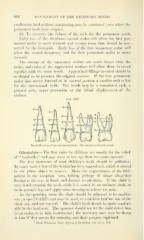Page 668 - My FlipBook
P. 668
666 MANAGEMENT OF THE DECIDUOUS TEETH.
s\v;illi)\\ inii' food without masticating may be continued even when the
permanent teeth have erupted.
3d. To preserv^e the fuhiess of the areli for the permanent teeth.
Early loss of the deciduous second molar will alhjw the first per-
manent molar to move forward and (xxnipy room that should be pre-
served by the bicuspids. Early loss of the first temporary molar will
allow the second temporary and the first permanent molar to move
forward.
The crowns of the temporary molars are much larger than the
necks, and caries of the approximal surfaces will allow them to crowd
together with the same result. Approximal fillings inserted should be
so shaped as to preserve the original contour. If the first permanent
molar thus moves forward of its natural position a smaller arch is left
for the successional teeth. The result may be a constricted arch, a
pointed arch, upper protrusion, or the labial displacement of the
canines.
Fig. 593.1
k
Decalcification of the deciduous teeth. The numbers indicate years.
Odontalgia.—The first visits by children are usually for the relief
of " toothache," and may occur at any age from two years upward.
The first treatment of most children's teeth should be palliative.
In many cases a fear of the dentist has been engendered, which it should
be the prime object to remove. Make the acquaintance of the little
patient in the reception room, talking perhaps of things altogether
foreign to the case in hand, and distract its attention. If the child is
very timid examine the teeth while it is seated in an ordinary chair, or
in its parent's lap, and apply some dressing to relieve the pain.
In the operating room the chair should be adjusted to its smallest
size ; a special child's seat may be used, or a cushion half the size of the
chair seat, and not too soft. The child's head should be made comfort-
able in the head-rest. The operator should not let the child detect him
in an endeavor to hide instruments ; the necessary ones may be shown
to him if they arouse his curiosity, and their purpose explained.
1 Prof. Pierce in Amer. System of Dentistry, vol. iii. p. 639.


